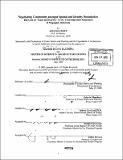| dc.contributor.advisor | John de Monchaux and Robert Cowherd. | en_US |
| dc.contributor.author | Ikert, Amanda | en_US |
| dc.contributor.other | Massachusetts Institute of Technology. Dept. of Architecture. | en_US |
| dc.date.accessioned | 2006-06-19T17:33:00Z | |
| dc.date.available | 2006-06-19T17:33:00Z | |
| dc.date.copyright | 2005 | en_US |
| dc.date.issued | 2005 | en_US |
| dc.identifier.uri | http://hdl.handle.net/1721.1/33019 | |
| dc.description | Thesis (S.M.)--Massachusetts Institute of Technology, Dept. of Urban Studies and Planning; and, (S.M.)--Massachusetts Institute of Technology, Dept. of Architecture, 2005. | en_US |
| dc.description | Includes bibliographical references (p. 146-153). | en_US |
| dc.description.abstract | In the 1970s, the Indonesian government undertook a massive national development program which involved the relocation of 1.5 million people throughout the islands of the archipelago. Known as transmigration, the program resettled people from Java and Bali, two islands experiencing overpopulation, urbanization and increasing poverty, to the "Outer Islands" of Sumatra, Kalimantan, Sulawesi, the Moluccas and Papua. One of the objectives of transmigration was the integration of the many ethnic and religious sub-communities throughout Indonesia to fashion Indonesian citizens which collectively would represent the national motto of Bhinneka Tunggal Ika, or "Unity in Diversity." Unfortunately, many of the transmigration settlements were established as exclusively Javanese or Balinese enclaves resulting in instances of inter-communal conflict with the indigenous groups. This thesis examines the unusual transmigration settlement of Mopugad, in Northern Sulawesi. Here the locus of integration is between two groups settled in the same town, creating an opportunity to assess whether the shared experience of migration is a condition of unification. | en_US |
| dc.description.abstract | (cont.) We can see that in Mopugad the two communities, one Javanese and the other Balinese, have remained largely distinct and are apparently becoming increasingly distinct due to the evolution of religious culture. The relationship between the two communities can partly be seen in the negotiation of cultural and administrative jurisdictions visible in the changing physical order of the town. Though diversity has been sustained at the expense of unity, it is not impervious to the changing circumstances facing the town which could allow a change in trajectory towards increased unity and a diminished diversity. Should residents of Mopugad jointly decide that diversity is a goal worth pursuit, they will have to work deliberately to sustain it by building local interdependence. The impending threat that nearby informal gold mining poses to the health and rice-farming livelihood of both sets of residents may be an opportunity upon which to base a conditional community, a precursor to shared communalism. The resulting shared communalism would be particularly applicable in other parts of the nation as Indonesia undergoes massive political and fiscal decentralization. The children of the pioneers of transmigration have the opportunity to become the new pioneers of decentralization. | en_US |
| dc.description.statementofresponsibility | by Amanda Ikert. | en_US |
| dc.format.extent | 153 p. | en_US |
| dc.format.extent | 13594566 bytes | |
| dc.format.extent | 13601651 bytes | |
| dc.format.mimetype | application/pdf | |
| dc.format.mimetype | application/pdf | |
| dc.language.iso | eng | en_US |
| dc.publisher | Massachusetts Institute of Technology | en_US |
| dc.rights | M.I.T. theses are protected by copyright. They may be viewed from this source for any purpose, but reproduction or distribution in any format is prohibited without written permission. See provided URL for inquiries about permission. | en_US |
| dc.rights.uri | http://dspace.mit.edu/handle/1721.1/7582 | |
| dc.subject | Urban Studies and Planning. | en_US |
| dc.subject | Architecture. | en_US |
| dc.title | Negotiating community amongst spatial and identity boundaries : the case of "unity in diversity" in the transmigration settlement of Mopugad, Indonesia | en_US |
| dc.type | Thesis | en_US |
| dc.description.degree | S.M. | en_US |
| dc.contributor.department | Massachusetts Institute of Technology. Department of Architecture | |
| dc.contributor.department | Massachusetts Institute of Technology. Department of Urban Studies and Planning | |
| dc.identifier.oclc | 62082453 | en_US |
